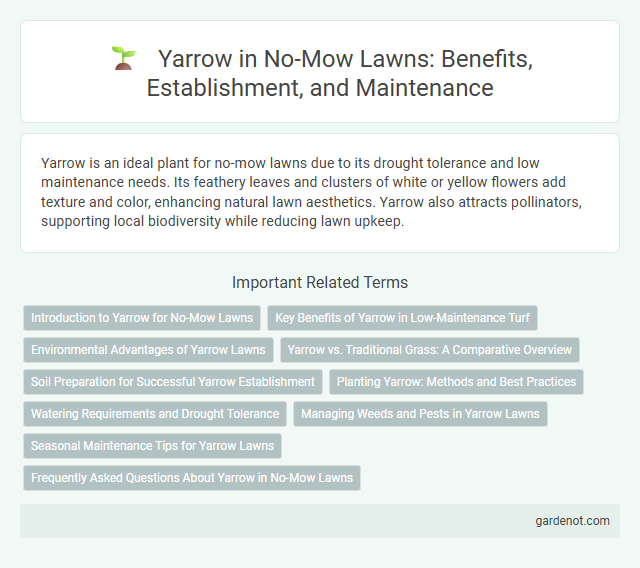Yarrow is an ideal plant for no-mow lawns due to its drought tolerance and low maintenance needs. Its feathery leaves and clusters of white or yellow flowers add texture and color, enhancing natural lawn aesthetics. Yarrow also attracts pollinators, supporting local biodiversity while reducing lawn upkeep.
Introduction to Yarrow for No-Mow Lawns
Yarrow (Achillea millefolium) is a hardy, drought-tolerant perennial ideal for no-mow lawns due to its low growth habit and ability to thrive in poor soils. This plant supports biodiversity by attracting pollinators such as bees and butterflies while requiring minimal maintenance. Integrating yarrow into no-mow lawns enhances aesthetic appeal with its fern-like foliage and clusters of small, white to pink flowers.
Key Benefits of Yarrow in Low-Maintenance Turf
Yarrow enhances low-maintenance turf by improving soil health and retaining moisture, reducing the need for frequent watering. Its deep root system stabilizes soil, preventing erosion and promoting drought resistance. The plant's natural pest-repellent properties minimize pesticide use, making it ideal for eco-friendly, no-mow lawns.
Environmental Advantages of Yarrow Lawns
Yarrow lawns significantly reduce water consumption due to their drought-resistant nature, making them an eco-friendly alternative to traditional grass. Their deep root systems improve soil health by preventing erosion and enhancing nutrient cycling. Yarrow's ability to attract pollinators like bees and butterflies supports biodiversity and promotes a balanced garden ecosystem.
Yarrow vs. Traditional Grass: A Comparative Overview
Yarrow thrives in no-mow lawns, offering drought resistance and low maintenance compared to traditional grass that requires frequent watering and mowing. Its dense growth suppresses weeds naturally, reducing the need for herbicides common in conventional turf care. Unlike traditional lawns that often suffer from bare patches and soil erosion, yarrow creates a durable groundcover that enhances soil health and biodiversity.
Soil Preparation for Successful Yarrow Establishment
Yarrow thrives best in well-drained, sandy or loamy soil with a pH between 6.0 and 8.0, ensuring optimal nutrient availability. Before planting, loosen the soil to a depth of at least 12 inches and incorporate organic matter such as compost to improve drainage and fertility. Proper soil preparation minimizes waterlogging and promotes strong root development, essential for establishing a resilient no-mow lawn featuring yarrow.
Planting Yarrow: Methods and Best Practices
Planting yarrow (Achillea millefolium) thrives best in well-drained soil with full sun exposure, ideal for no-mow lawn alternatives. Seeds should be sown directly in spring or early fall, ensuring light soil coverage to promote germination within two weeks. Dividing established clumps every three years maintains plant vigor and enhances ground coverage in no-mow landscapes.
Watering Requirements and Drought Tolerance
Yarrow (Achillea millefolium) thrives in well-drained soil and requires minimal watering once established, typically needing just occasional deep watering during prolonged dry spells. Its exceptional drought tolerance makes yarrow an ideal choice for no-mow lawns in arid or low-water conditions, reducing overall irrigation needs. This hardy perennial maintains vibrant foliage and flowers even under dry conditions, contributing to sustainable, low-maintenance landscapes.
Managing Weeds and Pests in Yarrow Lawns
Yarrow lawns naturally suppress weeds due to their dense growth and allelopathic properties that inhibit competing plants. Regularly inspecting for aphids and caterpillars helps maintain healthy yarrow, as these pests can damage foliage and reduce lawn vigor. Introducing beneficial insects like ladybugs supports pest control without chemical interventions, fostering a sustainable no-mow lawn ecosystem.
Seasonal Maintenance Tips for Yarrow Lawns
Yarrow lawns thrive with minimal mowing, but seasonal maintenance is essential for optimal growth. In early spring, trim dead stems to encourage new shoots and improve air circulation, promoting healthier foliage. Late summer pruning after flowering prevents legginess and supports a dense, attractive ground cover throughout the growing season.
Frequently Asked Questions About Yarrow in No-Mow Lawns
Yarrow in no-mow lawns is a hardy, drought-tolerant perennial that thrives with minimal maintenance, making it ideal for sustainable landscaping. Frequently asked questions include its tolerance to foot traffic, with yarrow generally able to withstand moderate use without damage. Gardeners also inquire about its growth habits, as yarrow spreads via rhizomes, which can help fill bare spots but may require occasional containment to prevent overgrowth.
Yarrow Infographic

 gardenot.com
gardenot.com